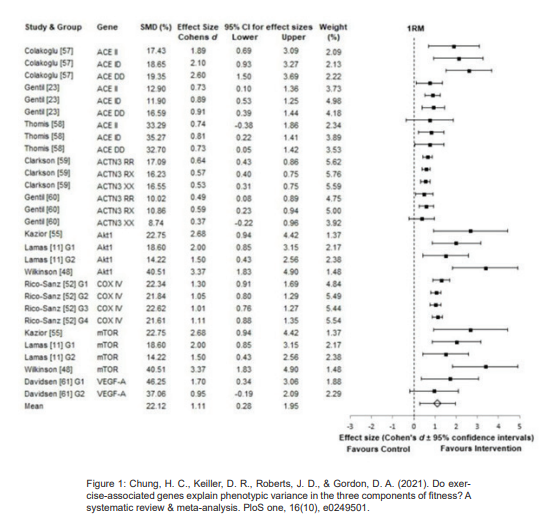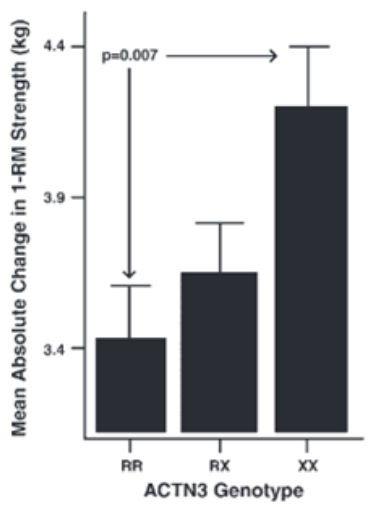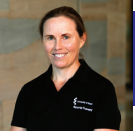Abstract
This brief overview and commentary explores the effect of exercise training on muscular strength, and the influence of genetics on the level of response and adaptation between individuals. We aim to outline and explore some limitations within the current research and discuss how future research could address these. Muscular strength is a vital component of health-related fitness, and is needed for exercise performance, health, general mobility, and activities of daily living (ADLs). The improvement of strength, especially in those that are physically inactive, is critical to improve and maintain an individual’s health and fitness. In this regard, current research supports the notion that an individual’s genetics play a significant role in the strength adaptions following training. It has been reported that up to 80% of the inter-individual variability following exercise training between individuals, can be explained by one’s there are significant differences in the improvements of strength between separate allele specific groups, following a standardised 12-week exercise intervention. Yet, an important omission in current research studies is that this genetic information in not clearly provided, meaning that results are over-generalised and difficult to compare to other studies, effectively reducing their ecological validity. We, therefore, propose recommendations for future research to address the current gaps within strength training and genetics. Furthermore, we suggest that future studies, where possible, try to employ a more transparent method of reporting genotype information.
Introduction
Over the decades, there has been an exponential increase in the pandemic known as physical inactivity and the concomitant increase in poor health, obesity, and disease cases (Blair, 2015). According to public health figures, physical inactivity is the cause of 1 in 6 deaths in the United Kingdom (UK), leading to many chronic conditions and diseases. This is estimated to cost a total £7.4 billion annually (approximately, £1 billion to the National Health Services (NHS) alone). The UK population is around 20% less physically active when compared to the 1960s and if this current trend continues, it is projected to increase to 35% by 2030 (Gov.uk, 2022).
This increasing concern is well supported by the UK national health statistics and reducing physical inactivity has become a priority for many reasons. In an effort to attenuate the rise in physical inactivity, there has been an increase in the information provided to the general public. The UK Chief Medical Officers’ Guidelines encourage individuals to take action by partaking in: 1) more moderate- or vigorousintensity activities, or a mixture of both, 2) muscle strengthening activities at least twice per week, and 3) reducing extended periods of sitting (Gov.uk, 2022). Of particular importance is the fact that muscular strength recommendations are becoming increasingly important in recent decades, since scientific evidence demonstrates that muscular strength is associated to many types of morbidity and mortality (Shaw, Shaw & Brown, 2011).
This is because an individual’s muscular strength is an important health-related component of fitness and is vital for everyday activities and quality of life, highlighting its integration into many updated health recom
mendations (Ratamess 2012). Muscular strength is necessary in many situations, including sports performance, exercise, or general mobility and lifting, and is essential for all lifestyles, age groups, and genders. Muscular strength has been linked to survival, injury prevention, health longevity, suppression and prevention of many chronic conditions and more (Landi et al., 2020; Lavie, Kachur & Sui 2019; Rantanen et al., 2012; Versteeg et al., 2018). Improving this health-related component of fitness is therefore fundamental, irrespective of individuals initial level of fitness (Peterson, Rhea & Alvar, 2005).
It is well established that strength is an adaptive process and can be improved via changes in muscle tissue morphology and neuromuscular function, as a result of specific resistance training modalities including, calisthenics and weightlifting (Vingren et al., 2010). Evidence indicates that individuals’ strength adaptations occur at different rates, even when matched to similar exercise protocols, training loads, and training volumes (Chung et al., 2021). In this respect, research has suggested that responses to exercise training, in general, have a heritable and veritable genetic component that influences the adaptation process (Spurway 2006). This is not surprising due to the many interaction’s genes have with energy-pathways, metabolism, muscle composition, tissue and cell growth, development, hormonal and enzyme interactions, that form the building blocks of life (Keiller and Gordon, 2020). Yet, there is a need for more research within this rapidly expanding field of genetics in exercise, especially in strength phenotypes.
In a recently published meta-analysis, a number of health-related fitness markers, were shown to be associated with certain candidate genes, in untrained, less active populations (Chung et al., 2021). Pooled results from the analysis showed significant improvements in strength variables, such as one-repetition maximum (1RM) of 22.1 ± 10.1%, when groups were exposed to a strength training intervention. A list of genes were identified to be associated with strength (see Figure 1).
More interestingly, subgroup analysis revealed that up to 72% of the total variability in this increase in strength was explained by genetic distributions. These outcomes are consistent with previous observations, which reported variabilities of up to 80% in a number of health and fitness phenotypes (Bouchard, 2012; Del Coso et al., 2019; Hautala et al., 2006). Such findings emphasise the importance of assessing an individuals’ genes, thereby, making these findings relevant in all populations in both a heath and performance settings.
Figure 1: Meta-analysis forest plot of strength. Improvements in strength (1-repetition maximum) post-training intervention across studies. Adjusted for study weighting and genetic subgrouping.

Shortcomings
Although findings between strength gains and genetics seem promising, there are several research limitations. In terms of applying genetic information in exercise studies, a major omission that is continuously repeated within the literature (especially in less researched genes), is the lack of allele and mutation variant specific information (genotype). In genetics, a gene may have many variants / polymorphisms, which could be identified more specifically (i.e., by rs number). Further, there are also different alleles that occupy that gene’s loci. Many studies fail to report these observations or generalise their findings for that gene. This information is key to differentiate specific genes and their roles, as without this information, it is increasingly difficult to replicate study observations and identify genotypes. This is important because one allele variant might be significantly more
beneficial to positive responses when compared to the alternative versions that might respond differently in the same situation / environment (Clarkson et al., 2005; Silva et a., 2015).
For example, the well-studied α-actinin 3 (ACTN3 R577X: rs1815739) has three different variants made from two alleles (Homozygote: RR and XX; Heterozygote: RX). In theory, the X stop codon allele, should promote greater ACTN2 expression and suppress ACTN3. This genotype has been shown to be overrepresented among endurance athletes, due to interactions with ACTN2 and type I muscle fibres that affect aerobic endurance ability (Del Coso et al., 2018; Gentil et al., 2012). In turn, the R allele, which promotes increases in strength phenotypes through ACTN3 expression, is overrepresented in strength and power athletes (Keiller and Gordon, 2019; Silva et al., 2015). Conversely, research has also shown that there are mixed results in observations in the influence of ACTN3 polymorphism (Chung et al., 2021; Clarkson et al., 2005; Gineviciene et al., 2016), in a wide cohort of 743, 602, and 1,524 participants, respectively.
Figure 2 illustrates the overall effect of the ACTN3 gene on training improvements in strength over 12-weeks. However, depending on the specific genotype the improvements are significantly different between groups (p = .007). In this example, those that possessed the XX genotype had greater improvements in strength even though the training was standardised across all groups. This means that those possessing the XX genotype were at a greater advantage com pared to those that were in the RR and RX genotype groups. Therefore, this reinforces the notion that gene information alone, without specifying the specific polymorphism and allele information has little merit when studying the genes effect on phenotypic health and fitness outcomes.

Figure 2: Gene-specific allele differences in 1RM. ACTN3 genotypes respond differently to standardised match exercise training, where XX genotype group improved the most. Source: Clarkson, P. M., Devaney, J. M., Gordish-Dressman, H., Thompson, P. D., Hubal, M. J., Urso, M., … & Hoffman, E. P. (2005). ACTN3 genotype is associated with increases in muscle strength in response to resistance training in women. Journal of applied physiology, 99(1), 154-163.
Another limitation of many mixed gender studies is, whether it be strength, genetics or both, that the results and effects are often blended without adjustments or covariance. In a transcriptome meta-analysis of muscle strength pathways (Pilling et al., 2016), researchers found that there were clear differences in strength developments between males and females. This is relatively unsurprising, considering the role that testosterone has in males and the relatively low amounts in females that combines with estragon, which again could be linked to genetics (Vingren et al., 2010). However, conflicting studies have displayed no association between testosterone and strength phenotypes (Alexander et al., 2021). Despite this, it must be noted that this evidence does not suggest that females cannot observe significant improvements in muscular strength phenotypes in the presence of exercise training (Kostek et al., 2005). However, it is clear that the genetic processes between males and females differ, as do the baseline strength and improvements from exercise training. Regardless, these are factors that should be considered and adjusted for in research but are often overlooked. Finally, it is important to note that studies investigating how much genetic variability explains phenotype changes, often link this as a measure of association. Although this is an important measure, this is not necessarily correct in terms of establishing relationships between variables, but rather, only the precision and dispersion of them (Roberts, Ashrafzadeh & Asgari, 2019). Therefore, studies should also be mindful of the specific statistical inferences that have been made.
Future research
Observations in the current literature provide evidence that certain genetics play a critical role in determining health responses and trainability. However, this is much more complex and requires further detailed study considerations. There is currently no common panel of genetic variants that can predict how well someone will respond to exercise training (Williams et al., 2021). We understand that research on genetics and exercise health following strength training is an area of increasing activity, and that many other disciplines contribute to the battle against physical inactivity and improvement in health. We, therefore, encourage research within this field make their methods and results as transparent as possible. Furthermore, it is doubtful that a single independent gene or polymorphism is dependently responsible for the change in a phenotype due to the human transcription network of signalling, which interlinks with other pathways and processes causing a cascade effect in genetic expression (Ahmetov et al., 2016). In addition, the shortcomings that have been highlighted in this commentary also provide insight to the current limitations within the research area.
We would therefore like to propose two necessary explorations that are currently lacking within the field:
1) Comprehensive systematic literature reviews and/or meta-analyses be undertaken to encompass research on the currently explored and verified gene polymorphisms and alleles, to specifically establish a list of genetic variants relevant to strength phenotypes.
2) Acute and longitudinal strength training intervention studies be undertaken to investigate a number of genes and their variants and their combined association in strength phenotypes. In conclusion, we propose that epigenetic research in response to strength training might provide valuable information to clinical and nonclinical professionals. Such information could serve as markers or outcome measures for the design and/or management of optimized and individualized training protocols or even as a prognostic tools to predict strength training adaptation.
DOI
https://doi.org/10.57259/GRJ8352
Bio

Dr Henry Chung is a lecturer and researcher at the University of Essex (UoE) School of Sport, Rehabilitation, and Exercise Science (SRES). He previously completed his Ph.D at Anglia Ruskin University in exercise genetics and has experience in Epidemiology working with a number of establishments, including the Medical Research Council, Addenbrookes hospitals epidemiology unit and the University of Cambridge (UoC).
Bio

Sally graduated as a Sports Therapist in 2001 and has since completed a MSc Sports Nutrition, a PhD Human Movement Science and is a Level 2 British Triathlon Coach. She has been involved with endurance sport for over ten years, completed six Ironman events, qualified for Kona and coached numerous endurance and multisport athletes of all levels. She currently leads the Sports Therapy programme at University of Essex.
Bio

Ina Shaw, PhD is currently the President of the International Physical Activity Projects (IPAP), Co-director of the Non-Communicable Disease Intervention Research Unit (NCDIRU), and Director: Clinical Exercise and Rehabilitation Cluster (CERC) at the University of Essex. (i.shaw@essex.ac.uk)
Bio

Dr Chris McManus is a lecturer in Sport and Exercise Science, Director of the Human Performance Unit at the University of Essex and BASES Accredited Sport and Exercise Scientist. His research interests include wearable technology and its application in sport, near-infrared spectroscopy (NIRS) and dietary interventions to enhance sports performance.
Bio

Brandon S. Shaw PhD, PhD has a distinguished tenure in sport and exercise sciences, health research and health management. He is currently an Executive Director of IPAP, Co-director of the NCDIRU, Audit Chair and Board Member at the Medical Research Council (SA), Visiting Professor, and Director of Internationalisation at the University of Essex (b.shaw@essex.ac.uk)
